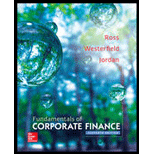
Concept explainers
a)
To determine: The share price after 5-3 stock split.
Introduction:
Stock split: A company divides its share into multiple shares and issues them to the shareholders as an additional share; as per the decisions by the management is termed as stock split.
To determine: New outstanding shares.
b)
To determine: The share price at 15% stock dividend.
Introduction:
Stock dividend: Distribution of dividend in the form of additional shares is termed as stock dividend. It is also termed as ‘Scrip dividend’.
To determine: New outstanding shares.
c)
To determine: The share price at 42.5% stock dividend.
Introduction:
Stock dividend: Distribution of dividend in the form of additional shares is termed as stock dividend. It is also termed as ‘Scrip dividend’.
To determine: New outstanding shares.
d)
To determine: The share price after 4-7 reverse stock split.
Introduction:
Reverse stock split: The Company reduces its share, which are outstanding. It is the opposite of forward stock splits. This works normally as a regular dividend but reverse action will take place.
To determine: New outstanding shares.
Want to see the full answer?
Check out a sample textbook solution
Chapter 17 Solutions
Fundamentals of Corporate Finance
- Pat’s Video Games has been struggling recently as it has been rumored that the owners are secret Dodgers fans. As a result, its stock price is now only $4 per share. It is going to declare a one-for-two reverse stock split to increase the stock value. a. If an investor owns 90 shares, how many shares will he own after the reverse stock split? b. What is the anticipated price of the stock after the reverse stock split? c. Because it became public knowledge that the owners of Pat’s Video Games were Dodgers fans (and used company proceeds to purchase Dodger paraphernalia, the stock price continued to drop even after the stock split. If the stock price only goes up to 75 percent of the value computed in part b. What will the stock’s price be? d. How has the total value of an investor’s holdings changed from before the reverse stock split to after the reverse stock split (based on the stock value computed in part c)? e. What important lesson did the investor learn?arrow_forwardPurrogi Cat Treats Inc. earned $500 million last year and retained $290 million in earnings. What is the payout ratio?arrow_forwardEthical dilemma: Republic Communications Corporation (RCC) has offered you an attractive position in its financial planning division. The new position would constitute a promotion with a $30,000 increase in salary compared to the job you now have at National Telecommunications, Inc. (NTI). The problem is that RCC wants you to bring the rate-setting software you developed at NTI, along with some rate data, with you to the new job. Even though NTI sells its software to other companies and information concerning telephone rates is available to the public, you know that such knowledge will help RCC significantly in its attempt to redesign its rate-setting system. In fact, according to the situation presented in the text, a new and improved rate-setting program could be worth as much as $200 million per year for RCC. Therefore, the question is whether the information RCC wants you to take with you to your new job is proprietary to NTI. Should the rate-setting program and the rate data be…arrow_forward
- Your traditional IRA account has stock of GFH, which cost $2,000 20 years ago when you were 50 years old. You have been very fortunate, and the stock is now worth $23,000. You are in the 32 percent income tax bracket and pay 15 percent on long-term capital gains. a. What was the annual rate of growth in the value of the stock? b. What are the taxes owed if you withdraw the funds? Answer to part b. is $8,050 *Please display all work & needed formulasarrow_forwardCan anyone figure this out correctly? I keep getting the wrong answers over and over? Cost of Trade Credit Grunewald Industries sells on terms of 3/10, net 40. Gross sales last year were $4,161,000 and accounts receivable averaged $370,500. Half of Grunewald's customers paid on the 10th day and took discounts. What are the nominal and effective costs of trade credit to Grunewald's nondiscount customers? (Hint: Calculate daily sales based on a 365-day year, calculate the average receivables for discount customers, and then find the DSO for the nondiscount customers.) Do not round intermediate calculations. Round your answers to two decimal places. 1.) Effective cost of trade credit:arrow_forwardExplain how an increase in interest rates by a central bank could affect bond prices and stock market performance. Explanation.arrow_forward
- What is the purpose of diversification in an investment portfolio, and how does it reduce risk?arrow_forwardExplain how an increase in interest rates by a central bank could affect bond prices and stock market performance.arrow_forwardWhat is the purpose of diversification in an investment portfolio, and how does it reduce risk? Need help!arrow_forward
- What are the key differences between a company’s income statement and its cash flow statement? Why are both important for financial analysis? Need help!arrow_forwardWhat are the key differences between a company’s income statement and its cash flow statement? Why are both important for financial analysis?arrow_forwardWhat is the relationship between risk and return in finance, and how is this reflected in the Capital Asset Pricing Model (CAPM)? Explain.arrow_forward
 Intermediate Financial Management (MindTap Course...FinanceISBN:9781337395083Author:Eugene F. Brigham, Phillip R. DavesPublisher:Cengage Learning
Intermediate Financial Management (MindTap Course...FinanceISBN:9781337395083Author:Eugene F. Brigham, Phillip R. DavesPublisher:Cengage Learning
